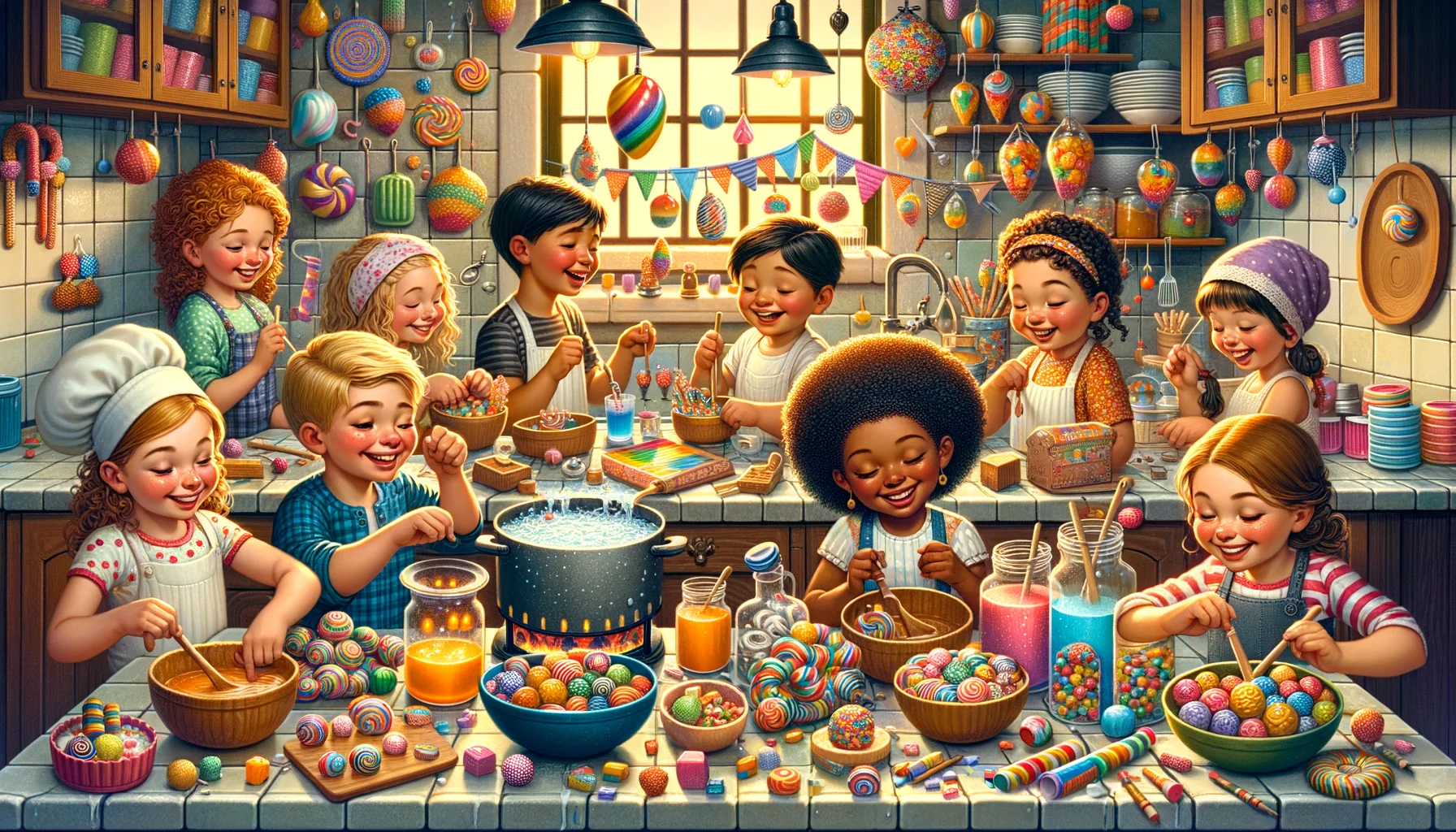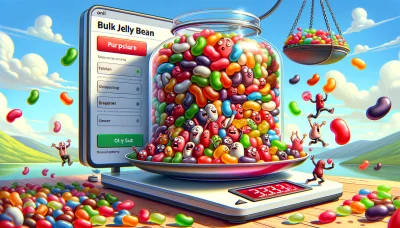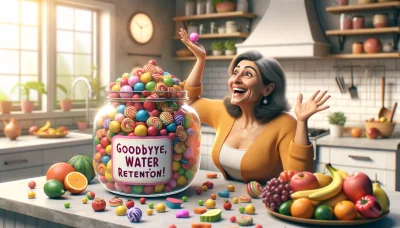Homemade Candy Kits for Kids Quiz
Test Your Knowledge
Question of
Choosing the Perfect Homemade Candy Kit for Kids
Age-Appropriate Candy Making Kits
Remember the time when a simple act of stirring chocolate felt like a magical potion brewing? That's the kind of whimsical charm I want to bring into my home with homemade candy kits for kids. But not all kits are created equal, and it's essential to consider the age of your little confectioner. For the tiny tots, safety is paramount. Look for kits that boast big, chunky tools easy for small hands to grip and non-toxic materials that can withstand the curiosity of a taste-test.
As kids grow, their ability to handle complexity blossoms like marshmallows in a cup of cocoa. The older they get, the more intricate their candy-making adventures can become. From simple chocolate dipping to multi-step gummy bear recipes, there's a satisfying challenge out there for every age. Manufacturers often specify recommended age ranges on their kits, which is incredibly helpful. A kit that says "Ages 8+" encourages me to trust that my nephew won't end up glued to a sticky mess rather than crafting edible masterpieces.
And then there are those delightful moments when you see your child's eyes light up as they achieve something on their own. That's what age-appropriate candy making kits do; they empower kids with the right level of complexity for their skill set, ensuring those sparkling moments of success aren't dulled by frustration or boredom.
Types of Candies You Can Create
The variety of candies you can create with these kits is vast enough to fill a whole candy store in your imagination! First up is the classic chocolate molding adventure . It's like painting, but instead of colors, we're using white, milk, and dark chocolates to fill in molds that could shape our treats into anything from dinosaurs to hearts. The scent alone is enough to make one swoon!
Then there are the gummy delights and shapes , which are akin to playing with your food but in an educational, chef-like manner. Kids can experiment with colors and flavors while learning about measurements and patience because waiting for gummies to set is truly a test of willpower. Each squishy creation is a testament to their culinary prowess.
Lastly, we venture into the shiny world of hard candy creations and lollipops . There's something utterly mesmerizing about watching sugar transform into glossy ambers and rubies on sticks. These kits teach an appreciation for temperature precision and timing skills even some adults (ahem, myself included) find challenging at times.
- Gleeful Chocolate Molding
- Squishy Gummy Forms
- Lustrous Hard Candies
Essential Tools Included in Kits
A good homemade candy kit doesn't just provide ingredients; it equips budding confectioners with essential tools it's like arming knights with swords before sending them off to battle dragons (or in this case, sugar dragons). The candy thermometer , user-friendly enough for kids, becomes their wand as they conjure sweets from bubbling cauldrons (or pots). Watching temperatures rise can be as thrilling as reaching the next level in a video game.
The heart of any candy kit has got to be its array of molds from simple spheres that could turn into planets for an edible solar system to intricate shapes that require a bit more dexterity. They're not just molds; they're vessels for creativity. And each shape tells a different story or sets the stage for one.
No epic tale would be complete without mentioning spatulas and mixing tools tailored for beginners; these are the trusty sidekicks in any candy-making quest. They help scrape every last bit of sweet goodness into molds, ensuring that nothing goes to waste because in the land of homemade candies, every drop is precious.
In this delicious journey through homemade candy kits for kids, we find more than just sugary treats; we discover lessons wrapped in chocolate foil, skills disguised as gummy bears, and laughter sprinkled over hard candies. So go ahead and choose your child's next adventure wisely it might just be sweeter than you think.
Educational Benefits of Candy Making with Kids
Learning Basic Cooking Skills
There's something magical about watching a child's eyes light up as they measure out sugar and stir it into a melting pot of potential. With homemade candy kits for kids, this isn't just about indulging in sweet treats; it's an adventure in acquiring fundamental cooking skills. The tactile experience of measuring ingredients accurately is a dance of precision and patience, where little hands learn the importance of following a recipe to the tee. I remember the first time my niece carefully leveled off a cup of flour, her tongue sticking out in concentration it was pure, unadulterated focus.
Then we delve into the world of heat and temperature control, where the kitchen transforms into a laboratory. Children discover that too much heat might lead to a caramel disaster, while too little could mean waiting ages for chocolate to melt. Through these experiences, they are not just making candy; they're learning life skills wrapped in a chocolate-coated learning curve. The delight on their faces when they understand why their fudge needs to cool slowly is worth all the sticky counters in the world.
And let's not forget the joy of following step-by-step instructions. There's a rhythm to reading a recipe, a kind of culinary choreography that guides little ones through the process. From pouring to mixing, boiling to setting each step is an opportunity to foster independence and build confidence. The pride that beams from them when they've completed each stage is sweeter than any confectionery.
- Measuring Ingredients Accurately
- Understanding Heat and Temperature Control
- Following Step-by-Step Instructions
Exploring Science Through Candy Making
The alchemy of candy making is not lost on kids. It's like an edible science experiment where they witness firsthand the chemistry of sugar and heat intertwining in a delicious dance. When we talk about sugar crystallization and how it can be both friend and foe depending on what sweet creation you're aiming for, their curiosity piques as if I've just revealed a secret universe hidden beneath their taste buds.
In this sugary quest, states of matter become more than just pages in a textbook; they become real-life phenomena as solids morph into liquids and sometimes gases right before their eyes. A simple lollipop becomes a lesson in physics as they watch sugar syrup boil vigorously then cool into something solid enough to crunch on.
But oh, when we introduce emulsifiers and stabilizers into our homemade candies, that's when their brows furrow in intrigue. "Why does this marshmallow feel so fluffy?" they ask, as I explain the role these ingredients play in creating different textures and consistencies. Every stirring session becomes an opportunity to unravel more mysteries of food science.
Enhancing Creativity and Design Skills
Candy making isn't all about following rules; it's also an immense playground for creativity. The process of color mixing and discovering flavor combinations is akin to painting with an edible palette only here you get to eat your art! I've seen children combine flavors with wild abandon, creating concoctions like 'strawberry-lemonade dreams' or 'chocolate-mint whispers'. Their eagerness to experiment is as contagious as their laughter when they realize that blue and yellow make green even in candy form!
The decorating techniques for attractive finishes are where finesse meets fun. Drizzling chocolate or applying sprinkles becomes an exercise in dexterity and design, often resulting in giggles over lopsided hearts or overly enthusiastic glitter applications. But amidst these moments lie lessons in aesthetics and presentation that will serve them well beyond our kitchen escapades.
Packaging and presenting candies creatively might seem like the final step, but it's often where kids shine brightest. They meticulously craft labels and choose ribbons as if their candy creations were gifts for royalty because to them, sharing these treats is an act of love. Watching them take such care in this process reminds me that through these sweet endeavors, we're nurturing not just future chefs but thoughtful individuals who find joy in every detail.
Setting Up Your Candy Making Station at Home
Selecting the Right Space for Candy Making
Imagine the scent of sugar and spice wafting through the air as you embark on a confectionery adventure with your little ones. The first step to this magical journey is choosing a spot in your home where creativity can flow as freely as melted chocolate from a ladle. You'll want to find a nook that's not just cozy but also practical. A kitchen island or a sturdy table with ample space becomes the stage for your sweet symphony.
I remember when I first set up my candy making station, I looked for surfaces that were easy-to-clean because, let's face it, making candy is akin to inviting a sticky, glittery chaos into your home. Materials like stainless steel or granite are not just sleek to look at but also forgiving when it comes to those inevitable syrup splatters and spills. And lighting! Good lighting is crucial it's like the spotlight on your little sous-chef's masterpiece, ensuring every sprinkle and swirl is perfectly placed.
But before you unleash the tidal wave of sugary delight, think about safety and storage. Lockable cabinets or high shelves are perfect sanctuaries for those tempting ingredients and sharp tools, keeping them away from curious little hands until it's showtime.
Preparing for a Mess-Free Experience
Now, lets talk strategy because any general heading into a candy battle needs one. Outfitting your budding pastry chefs in aprons turns them into mini professionals while protecting them from becoming modern art pieces. Silicone mats? They are the unsung heroes of mess management. Lay them out and watch the magic happen; they'll catch every stray drop of gooey goodness, making cleanup as easy as licking a lollipop.
I've learned that organizing ingredients beforehand isn't just about convenience; it's about giving kids the confidence that they have everything they need at their fingertips. It's like setting them up on a treasure hunt where they know X marks the spot for the sugar, and theres a trove of food coloring just waiting to be discovered.
Cleanup tips ah, now that's something I wish I had known earlier! Did you know that oil can be your best friend when it comes to cleaning sticky candy tools? A little dab on a paper towel can make tackling that hardened sugar glue less of an epic quest and more of a swift victory.
Safety Precautions to Keep in Mind
Embarking on this sugary adventure should always be wrapped in layers of care and precaution. Having guidelines for supervision tailored to different age groups ensures everyone knows their roles. The younger ones might get stirring duties while the older kids handle the pouring teamwork makes the dream work!
No matter how much fun we're having, we must prepare for those "oops" moments too. Knowing basic first aid for minor burns or accidents gives peace of mind because sometimes even with the most careful preparation, mishaps can happen when you least expect them.
- Allergy Awareness: Before diving into our candy concoctions, it's essential to be aware of allergies. Whether its nuts or dairy lurking in our ingredients, substitutions are our secret weapon for inclusive feasting.
- Ingredient Substitutions: Swap out nuts for seeds or use dairy-free chocolate these little tweaks ensure that everyone can indulge without worry.
- Labeled Containers: Keeping everything labeled helps avoid mix-ups and makes sure that everyone can enjoy their creations safely.
In conclusion, setting up your homemade candy kit station is more than just about making treats; its about creating memories dipped in chocolate and sprinkled with laughter. Its about empowering our kids with creativity while savoring lifes simple pleasures together.
Fun Candy Making Projects for Special Occasions
There's something about the ritual of candy making that feels like a throwback to a simpler, sweeter time. Whether it's the scent of sugar beginning to caramelize or the vibrant colors swirling through a batch of homemade lollipops, these moments stir up a kind of childlike wonder that we sometimes forget in our busy lives. And when special occasions roll around, these candy making projects become not just fun activities, but heartfelt memories in the making.
Imagine your kitchen transforming into a confectionery lab where laughter is the best soundtrack and sticky fingers are a badge of honor. It's here, amidst measuring spoons and melting pots, that families bond and friendships deepen. With homemade candy kits designed for kidsand lets be honest, adults toothese sweet endeavors become all the more accessible and delightful. You dont have to be a culinary wizard; you just need a dash of enthusiasm and a sprinkle of creativity.
Holiday-Themed Candy Creations
When the calendar pages turn to those festive months, holiday-themed candy creations take center stage. These sugary delights are not just treats; they're tiny edible embodiments of the season's spirit. Crafting these goodies with your kids can become a tradition as cherished as hanging stockings or lighting the menorah.
- Halloween Candy Molds and Ideas: As October skies darken earlier each evening, and whispers of ghouls and goblins fill the air, Halloween candy molds beckon with their spooky shapes. Imagine crafting ghostly marshmallows or pumpkin-shaped chocolates that seem to giggle at the thought of scaring someone.
- Festive Christmas Candy Treats: When Decembers chill sets in, what better way to warm hearts than with festive Christmas candy treats? Picture peppermint bark that crackles like a Yule log fire or gingerbread fudge that hugs your taste buds like a cozy blanket.
- Valentine's Day Heart-Shaped Sweets: And as February unfolds its rosy petals, heart-shaped sweets become tokens of affection. Crafting these with little hands might result in asymmetrical hearts and uneven icing, but isn't there something endearing about an imperfect declaration of love?
The beauty of these holiday candies lies not just in their flavors but in their ability to capture the essence of joyous times. They serve as delicious reminders that life is sweet indeed.
Birthday Party Candy Making Activities
I remember one birthday when I decided to ditch the traditional cake for something more interactive: a candy-making extravaganza! The air was electric with anticipation as each child donned an apron, ready to dive into their own sugary masterpiece.
The table was an explosion of colors and textures, from smooth chocolate bars waiting to be personalized with nuts and candies to bubbling pots ready for eager little chefs to create their own concoctions. Here are some ideas you might find equally enchanting:
- Personalized Candy Bars as Party Favors: Who needs goody bags when you can send guests home with chocolate bars molded by their own hands? With wrappers they've decorated themselves, these treats are more than just dessertsthey're mementos.
- Interactive Candy Making Stations for Guests: Set up stations where guests can roll truffles in cocoa powder or dip pretzels in melted chocolate. Its like each child is helming their own dessert food truck!
- Themed Candy Kits Matching Party Themes: Whether it's pirates or princesses gracing your party theme, themed candy kits add an extra layer of magic. Imagine tiara-shaped lollipops or treasure chest gummiesthese sweets are sure to spark imaginations.
In these moments, you're not just filling bellies with sweetness; you're filling hearts with happiness. And perhaps that's the secret ingredient in any homemade candythe joy it brings.
Educational School Projects with Homemade Candies
Candy making isn't all fun and gameswell, it's mostly fun and gamesbut it can also be surprisingly educational! I've seen eyes light up in science class when students understand crystallization by making rock candy crystals sparkle like geodes on wooden sticks.
In history class, we've traveled back in time through taste by recreating sweets from different erasan edible timeline if you will. Let me share some ways homemade candies can turn into learning adventures:
- Science Fair Projects Featuring Candy Making: The chemistry behind confections is fascinating stuff! Observing sugar transform at different temperatures can teach principles of thermodynamics and physical changes in matter.
- Historical Lessons Through Traditional Sweets: What did ancient civilizations enjoy for dessert? Students might explore this question by making honeyed treats reminiscent of those enjoyed in Egyptian times or boiled sweets from the Victorian era.
- Art Class Edible Sculptures: Why limit sculptures to clay or paper? Edible sculptures challenge students to think about structure and design while also considering flavor profilesit's art you can eat!
The classroom becomes a place where theory meets practice, where learning is sweetened with every successful (and sometimes not-so-successful) batch of candies made by curious minds. It turns out that perhaps one way to digest knowledge is quite literally through delicious experiments!
Integrating Homemade Candy Kits into Family Activities
Bonding Over Shared Candy Making Experiences
There's something about the sticky sweetness of candy, the vibrant swirls of color, and the anticipation of a sugary treat that just brings people together. As I think back to the weekends spent with my family, I remember how we'd clear our kitchen table, set out all the ingredients, and open up our homemade candy kit. The air would fill with a symphony of excited chatter and laughter. Collaborative projects like these have a way of bridging gaps, turning siblings into teammates and parents into advisors in the whimsical world of candy making.
It wasn't just about making candy; it was about creating family traditions with seasonal candies that became part of our collective identity. Halloween meant spooky-shaped gummies, Christmas called for peppermint sticks, and Easter wasn't complete without chocolate eggs. We'd snap photos at every stage from pouring the molten sugar to the final decoration capturing joyous faces smeared with a dusting of powdered sugar or sticky fingers holding up proud creations.
These photo albums became treasure troves of memories. Flipping through them now evokes not only the flavors but also the feelings from those days: the warmth of togetherness, the pride in making something from scratch, and the giggles when things didn't turn out quite as expected. Memory-making with photo albums has become as much a part of our family as our secret recipe for butterscotch drops.
Weekend Fun with Homemade Candy Competitions
Speaking of butterscotch drops, they were my secret weapon in our weekend fun with homemade candy competitions. There's nothing quite like stirring up a little friendly rivalry alongside your caramel sauce! We'd divide into teams kids versus adults to see who could concoct the most delicious or creatively shaped confections.
- Organizing Friendly Family Bake-offs
- Award Categories for Taste, Creativity, and Presentation
- Keeping Score and Celebrating Winners
We even had a makeshift trophy that would sit on the winner's shelf until the next bake-off. The real prize though was bragging rights and the chance to be head chef in next week's family dinner preparation. Keeping score added an extra layer of excitement, but celebrating winners was always done over shared bites of everyones creations because let's be honest everyone wins when there's candy involved.
Encouraging Healthy Eating Habits Through Homemade Candies
You might wonder how indulging in homemade candies can encourage healthy eating habits well, let me tell you! Making candies at home gave us control over what went into them. We experimented with natural sweeteners like honey and maple syrup instead of reaching for refined sugars. It felt like alchemy, transforming simple ingredients into shiny lollipops or chewy fruit leathers.
Portion control was another lesson learned early on. When you're involved in making your treats, you tend to savor them more slowly; each piece becomes special because you know the effort that went into it. This mindfulness around consumption taught us moderation without taking away any of the delights that come from a well-deserved indulgence.
The benefits of homemade versus store-bought candies were multifold: fewer preservatives for sure, but also an appreciation for craftsmanship. We learned to value quality over quantity and discovered that sometimes less really is more especially when it comes to sweets crafted by your own hands.
Nutritional Considerations When Making Candies at Home
There's something magical about the alchemy of homemade candy, isn't there? The bubbling cauldron of sugar and the anticipation of that first, blissful bite. But as we stir the pot, let's not forget to sprinkle in a dash of mindfulness into our confectionery concoctions. Nutritional considerations can seem like a party pooper lurking in the shadows of our candy-making fiesta, but I promise, with a little creativity, we can invite it to dance alongside taste and enjoyment.
Embarking on this sweet endeavor with kids is not just about fun; it's an undercover mission to instill healthy habits. Who knew that a homemade candy kit could be a stealthy vessel for such noble pursuits? So, as we don our aprons and chef hats, let's navigate the sugary waters with a compass pointing towards healthier choices.
Choosing Healthier Ingredients for Your Candies
The days of guilt-ridden indulgence are behind us as we embark on a journey to make candies that aren't just delicious but also somewhat virtuous. Imagine the pride in telling your taste buds that they're savoring alternative sweeteners with lower glycemic indexes. Yes, dear friends, swapping out refined sugars for honey, agave nectar, or even stevia can add an interesting twist to your treats while keeping those pesky blood sugar spikes at bay.
And then theres the delightful crunch of nuts and chewiness of dried fruits! These aren't mere accessories to your candies; they are nutritional superheroes caped in fiber and antioxidants. Almonds, walnuts, and cashews bring their A-game packed with healthy fats and protein. Raisins, apricots, and dates? Theyre natures candy - adding natural sweetness along with a fiber-rich punch. And lets not forget about dark chocolate that rich, decadent relative of milk chocolate who also happens to be loaded with antioxidants. Opting for dark chocolate over its milkier cousin is like choosing a luxury sedan over a compact car youre just upgrading to something that feels better and is better for you.
Understanding Food Labels and Nutritional Content
Ah, food labels - those cryptic scrolls that adorn our food packages. Deciphering ingredient lists on packaging is akin to reading ancient hieroglyphs sometimes. But fear not! With a little practice, you'll be translating those "enriched flour" and "high fructose corn syrup" phrases like an expert linguist. It's about knowing which ingredients are simply different names for sugar and which additives sound more like they belong in a science experiment than in your body.
Now onto the number crunching - calculating calories and sugar content isn't exactly what I'd call a joyous pastime. Yet understanding what goes into our bodies is crucial when crafting homemade candies. It's like being a financial advisor for your health - you need to know where every gram of sugar is being invested! And identifying additives and preservatives to avoid? That's setting ground rules for unwanted guests at your health party.
- Deciphering Ingredient Lists: Look out for words ending in '-ose' they're usually sugars in disguise.
- Calculating Calories: Keep an eye on serving sizes; they can be misleadingly small!
- Identifying Additives: If it sounds more complicated than your high school chemistry homework, perhaps give it a miss.
Catering to Dietary Restrictions and Allergies
The beauty of homemade candies is that they can be tailored to suit any dietary restriction or allergy under the sun (or in our kitchens). Gluten-free options abound when you start exploring the world beyond wheat think rice flour or almond meal as bases for your sweet creations. Vegan candy options are no longer just a dream from the future; they're here and they're spectacular! Substitutes like coconut oil or plant-based milks can work wonders in place of dairy.
For those navigating the stormy seas of nut allergies - fear not! Nut-free kits ensure that everyone can partake in the candy-making revelry without worry. And lactose intolerance? It doesn't stand a chance against the myriad dairy substitutes waiting to be whisked into your recipes - hello oat milk chocolate bars! The point is clear: no one should have to miss out on the joy of candy making due to dietary restrictions or allergies. We're all aboard this sweet train together!
Tips for Storing and Preserving Homemade Candies
Best Practices for Freshness and Longevity
As someone who has dipped their hands into the sugary abyss of candy-making, I've learned that creating homemade candies is only half the battle; preserving their delightful taste and texture is the other. Let's talk about airtight containers first. There's something oddly satisfying about the 'whoosh' sound they make, sealing away freshness as if you're trapping a tiny bit of magic inside. Proper sealing techniques are absolutely essential to prevent moisture from turning your candy creations into sticky disappointments.
Now, onto the climate of your candys environment. Ideal temperature and humidity conditions are like finding the perfect spot on your pillow at night. It's crucial. Store your candies in a cool, dry place to avoid them turning into a science experiment gone wrong. And here's a little trick I picked up: labeling batches with dates not only helps with optimal consumption but also adds an unexpected touch of professionalism to your homemade treats.
Freezing Techniques for Extending Shelf Life
I used to think freezing was for leftovers and peas, but it turns out its a candy's best friend when it comes to longevity. Preparing candies suitable for freezing is like dressing them up in little winter coats, ready for the chill. But remember, not all candies are built for the cold; some might protest by losing their texture or flavor.
Thawing methods can be as delicate as defusing a bomb okay, maybe not quite that intense, but close! The key is to retain quality and flavor without any casualties along the way. Gentle thawing at room temperature tends to work wonders. And heres a neat little hack: portioning candies before freezing ensures you only grab what you need, leaving the rest undisturbed in their frigid slumber.
- Preparing Candies Suitable for Freezing: Choose high-sugar content candies; they freeze better.
- Thawing Methods to Retain Quality and Flavor: Room temperature works best; avoid direct sunlight or heat sources.
- Portioning Candies Before Freezing: This allows for easy access and helps maintain quality by avoiding repeated freeze-thaw cycles.
Creative Packaging Ideas for Gifting Homemade Candies
If youre like me and believe that presentation is nearly as important as taste, then youll love getting creative with packaging homemade candies. Decorative boxes can turn a handful of sweets into a treasure trove of delights. Wrapping techniques? Let's just say I've spent more time than Id care to admit perfecting my candy origami skills.
Custom labels and tags add that personal touch that says 'I might have licked the spoon, but I made this with love.' They also serve as tiny canvases for inside jokes or heartfelt messages. And if you're feeling particularly crafty, assembling gift baskets with assorted candies is like creating a bouquet of flavors each piece complementing the next in both taste and appearance.
Troubleshooting Common Candy Making Challenges
Dealing with Crystallization Issues
Oh, the sweet symphony of sugar and water dancing together in a pot, only to be thwarted by the sneaky crystallization! It's like a plot twist in your culinary narrative that you didn't see coming. Identifying the causes of sugar crystals can be as elusive as understanding why we always choose the slowest checkout line. One common culprit is undissolved sugar clinging to the sides of your pot like a stubborn barnacle. Another might be stirring the sugar mixture with too much zeal, inadvertently introducing rogue sugar crystals back into the mix.
Now, how do we outsmart these tiny saboteurs? Preventative measures during cooking are key. It's about being as gentle as a whisper no sudden movements or aggressive stirring. A pastry brush dipped in water becomes your sword to brush down any sugar crystals on the side of the pan, keeping them from staging a coup.
If you find yourself staring at a pot of what looks like rock candy gone wrong, don't despair! Salvaging a batch that has crystallized can sometimes be as simple as adding a bit more water and reheating gently to coax those crystals back into sweet submission. It's like giving your candy a second chance at life, and who doesn't love a good redemption story?
Achieving the Perfect Consistency Every Time
The quest for perfect candy consistency is akin to an alchemist's pursuit of turning metals into gold. It's an art form where precision meets intuition. Adjusting recipes for humidity and altitude changes is essential because making candy in Denver is going to be a different ball game than in New Orleans. Humidity can make your candy feel like it's taken a leisurely swim in the ocean, while altitude can affect cooking temperatures and leave you with something that resembles molten lava rather than delightful taffy.
Recognizing the stages of cooked sugar is like learning a new language; once you're fluent, you'll know exactly when to take your concoction off the heat. Whether its reaching "soft-ball" or "hard-crack" stage, it's all about using your senses watching for bubbles that look just right, feeling the texture when dropped in cold water, and sometimes just trusting your gut.
Tips for smooth textures in creamy candies are treasured secrets among confectioners. Adding an acid like cream of tartar can prevent crystallization and ensure that velvety texture we all crave in caramels and fudges. And remember to treat your mixture with care overbeating can turn your silky masterpiece into a grainy mess faster than you can say "Oops!"
Mastering the Art of Chocolate Tempering
Understanding the science of chocolate crystals might seem daunting, but its really about getting those tiny cocoa soldiers to fall into formation. When they align just right, they create that satisfying snap and glossy sheen that makes chocolate so irresistible. Its like organizing a group project where everyone actually cooperates pure magic!
Heres a step-by-step guide to proper tempering techniques:
- Gently melt your chocolate until its smooth and has reached about 115F (for dark chocolate), being careful not to scorch it.
- Cool down the chocolate by adding unmelted pieces or spreading it on a cool surface, stirring constantly until it reaches about 81F.
- Reheat slightly to between 88F and 90F for dark chocolate (a tad cooler for milk or white varieties), ensuring it stays within this tempering window until used.
If you've ever encountered bloomed or seized chocolate, you know it's enough to make a grown adult whimper softly into their apron. Bloomed chocolate looks like it was dusted with snow pretty but not ideal for eating. Seized chocolate is when moisture crashes the party and turns everything into an unappetizing clump. Fixing these mishaps requires patience and perhaps some wizardry; bloom can often be fixed by re-tempering while seized chocolate might become ganache or hot cocoa after adding more liquid and gently reheating.












